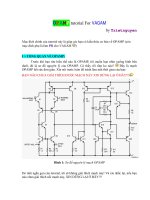TUTORIAL FOR CHAPTER 3
Bạn đang xem bản rút gọn của tài liệu. Xem và tải ngay bản đầy đủ của tài liệu tại đây (542.55 KB, 5 trang )
BLM256 DATA COMMUNICATIONS
TUTORIAL FOR CHAPTER 3
PROBLEM 1:
Given figure shows the effect of eliminating higher-harmonic components of a square
wave and retaining only a few lower harmonic components. What would the signal look
like in the opposite case; that is, retaining all higher harmonics and eliminating a few
lower harmonics?
SOLUTION:
The signal would be low-amplitude, rapidly changing waveform like following signal.
PROBLEM 2:
Given an amplifier with an effective noise temperature of 10,000oK and a 10-MHz
bandwidth, what thermal noise level may we expect at its output?
SOLUTION:
N = 10 log k + 10 log T + 10 log B
= -228.6 dBW + 10 log 104 + 10 log 107
= -228.6 + 40 +70 = - 118.6 dBW
PROBLEM 3:
What is the thermal noise level of a channel with a bandwidth of 10 kHz carrying 1000
watts of power operating at 50oC?
SOLUTION:
N=1.38x10-23x(50+273)x10,000 = 4.5x10-17 watts
PROBLEM 4:
Given a channel with an intended capacity of 20 Mbps, the bandwidth of the channel is 3
MHz. Assuming white thermal noise, what signal to noise ratio is required to achieve
this capacity?
SOLUTION:
C=B log2 (1+SNR)
20x106=3x106x log2 (1+SNR)
log2 (1+SNR)=6.67
1+SNR=102
SNS=101
PROBLEM 5:
If an amplifier has a 30 dB voltage gain, what voltage ratio does the gain represent?
SOLUTION:
For a voltage ratio, we have
NdB=30=20log (V2/V1)
V2/V1=1030/20=101.5=31.6
PROBLEM 6:
If the solid curve in following figure represents sin( 2π ) , what does the dotted curve
represent? That is, the dotted curve can be written in the form A sin( 2πft + φ ) ; what are
A, f , and φ ?
SOLUTION:
2 sin( 4πt + π ); A = 2, f = 2, φ = π
PROBLEM 7:
Assume that the TV picture is to be transmitted over a cannel with 4.5-MHz bandwidth
and a 35-dB signal-to-noise ratio. Find the capacity of the channel (bps).
SOLUTION:
PROBLEM 8:
Suppose a transmitter produced 50 W of power.
a) Express the transmit power in units of dBm and dBW.
b) If the transmitter’s power is applied to a unity gain antenna with a 900-MHz
carrier frequency, which is the received power in dBm at a free space
distance of 100 m?
SOLUTION:
PROBLEM 9 (Chapter 3 Problem 3.7):
SOLUTION:
PROBLEM 10 (Chapter 3 Problem 3.8):
SOLUTION:
PROBLEM 11:
The square wave of Figure 3.7 c, with T=1 ms, is passed through a lowpass filter that passes
frequencies up to 8 kHz with no attenuation.
a) Find the power in the output waveform.
b) Assume that at the filter input there is a thermal noise voltage with N0=0.1 µ Watt /Hz,
find the output signal to noise ratio in dB.
SOLUTION:
PROBLEM 12:
If the received signal level for a particular digital system is -151 dBW and the receiver
system effective noise temperature is 1500 K, what is Eb/N0 for a link transmitting 2400 bps?
SOLUTION:
PROBLEM 13:
What is the channel capacity for a teleprinter channel with a 300 Hz bandwidth and a signalto-noise ratio of 3 dB, where the noise is white thermal noise?
SOLUTION:
PROBLEM 14:
Adigital signaling system is required to operate at 9600 bps.
a) If a signal element encodes a 4 bit word, what is the minimum required bandwidth of
the channel?
b) Repeat part (a) for the case of 8-bit words.
SOLUTION:
PROBLEM 15:
What is the thermal noise level of a channel with a bandwidth of 10 kHz carrying 1000 watts
of power operating at 500C?
SOLUTION:
PROBLEM 16 (Chapter 3 Problem 3.13,a,b,7):
SOLUTION:









